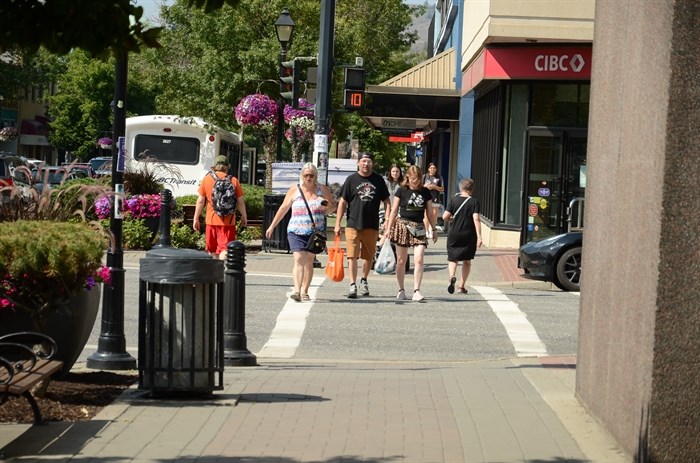'We know how to do this better': How Vernon pedestrians could be safer

This was one of Lynza Henke’s favourite times of year.
She made fudge to sell at the IPE for the last seven years and this year, she was determined to make 1,000 pounds of it in 100 different flavours she could display with the rest of her family’s candy apples, always a hit at the annual event.
But she brought no fudge to Vernon’s agricultural fair this year. The 15-year-old girl was fatally wounded while crossing the street in a crosswalk in downtown Vernon last month and died two weeks ago. There’s only the memory of her ambition, as relayed in her obituary.
We don’t yet know exactly what happened that July day — she was hit by a driver making a right-hand turn, police said — but we do know it could have been prevented.
iNFOnews.ca spoke with many pedestrians last week and most said the intersection — and several others along busy Highway 97 — just didn’t feel safe. Later the same day we spoke to them, two more pedestrians were hit in a market crosswalk just one block away.
Experts consulted by iNFOnews.ca say better road design and changing car culture could go a long way to making BC and Canadian roads safer, and catch up with parts of the world that could show a better way.
"We know how to do this better," Pamela Fuselli told iNFOnews.ca. She’s the president of Parachute, a Canadian injury prevention charity.
"We know how to prevent these (deaths)."
She said there are some relatively simple and inexpensive ways of making intersections safer.
Prohibiting right turns on red lights, which only became legal in the 1970s during the energy crisis, is one way.
“From a safety perspective, we know that is really effective," she said.
Giving pedestrians a buffer in time — a green walk sign several seconds before traffic has a green light — has been proven to reduce vehicle collisions with pedestrians by up to 58%, she said.
Holding all four lights at an intersection on red at the same time to allow pedestrians to cross the road has also proven effective.
Another more costly way is to raise pedestrian crosswalks at intersections and put islands in the middle of roads giving pedestrians a safe haven.
"No one should be killed or injured on our roadways and there are ways to change the environment that would support that," Fuselli said.
Canada does a little better than the US, but has higher rates of pedestrian deaths compared to many other industrialized countries.
According to ICBC, 80 per cent of crashes involving pedestrians happen at intersections. On average, roughly 300 pedestrians are killed on Canada's roads each year, a consistent number in recent years.
In 2020, worked out to a ratio of 0.8 per 100,000 people.
According to the European Road Safety Observatory in Germany, a country with more than double the population of Canada, 421 pedestrians were killed in 2019, that's 0.5 per 100,000. In France, it was 0.7 per 100,000.
In 2020, the UK had an average of 0.6 pedestrian fatalities per 100,000 people. The system in the UK doesn't allow vehicles to cross pedestrian walkways when they have a green walk sign.
In Denmark the number dropped to 0.4 per 100,000 people - half that of Canada.
Australia might be a closer comparison by road width and similar car culture but still had far less pedestrian fatalities than Canada at 0.5 per 100,000.
What’s the difference?
"Almost all of those (road design) standards are about the movement of cars," UBC professor Kelly Clifton told iNFOnews.ca.
Our road infrastructure prioritizes free vehicle movement over nearly anything else. Anything that slows vehicles is often seen as a bad thing.
"They are unpopular, there's a lot of backlash," she said.
She said it's "baffling" that while the engineering fixes to make roads safer for pedestrians exist and are known, little has been implemented.
And advice from the authorities seems to put some of the blame on the pedestrians themselves.
A 2023 Transport Canada "Road Safety in Canada" brochure tells pedestrians to wear "light or reflective clothing at night.”
Last winter Richmond RCMP received significant flack after releasing a public service video showing a driver playing on their phone who almost hit a pedestrian. The RCMP suggested safety was a "two-way street" but public backlash pointed out that only the driver was performing an illegal act.
Attitudes from the authorities show that there's complacency about the safety of our roads.
"The vast majority of them are preventable… there are ways to engineer out these issues... and fatal injuries," Fuselli said.
Back at home, some Vernon residents aren’t satisfied. Robyn Danielsson says council needs to take action and make safety a leading priority.
"Right now our town and merchants of downtown are grieving Lynza’s tragic death, it could also be an opportunity to rally as a community and protest about the fact that the problem needs action and made a priority," Danielsson said. "There is a theme brewing as many pedestrians are in danger when it comes to walking our streets, particularly at crosswalks around town that are designated for pedestrians but do not have flashing lights."
But if the public were expecting the death of a 15-year-old Vernon teen to spur politicians into action they'd be mistaken.
City of Vernon acting Mayor Teresa Durning refused to comment on the safety of the intersection. iNFOnews.ca asked the acting mayor for comment as Vernon Mayor Victor Cumming is currently away. Vernon's newest councillor, Brian Guy, also refused to comment.
While the city has plenty of input about design standards, most of the dangerous intersections are provincial responsibility, since they involve Highway 97.
Provincial MLA Harwinder Sandhu refused an interview but said in a statement that safety was her government's top priority.
"I have been and will continue to be a strong advocate in making sure that we are doing all we can to keep people safe on Highway 97," she said, without offering or seeking any specifics.
Fatalities like Henke's are an opportunity for the public to push for better and safer roads, and things do and can change.
In 1970 in the Netherlands 609 pedestrians were killed, but following a huge infrastructure redirection by 2008 that number had dropped to 56.
"It doesn’t happen overnight and it’s not inconsequential in terms of financial burden but when you make it a priority and you put someone accountable for it and you put resources to it you can make those differences," Fuselli said.
To contact a reporter for this story, email Ben Bulmer or call (250) 309-5230 or email the editor. You can also submit photos, videos or news tips to the newsroom and be entered to win a monthly prize draw.
We welcome your comments and opinions on our stories but play nice. We won't censor or delete comments unless they contain off-topic statements or links, unnecessary vulgarity, false facts, spam or obviously fake profiles. If you have any concerns about what you see in comments, email the editor in the link above. SUBSCRIBE to our awesome newsletter here.




